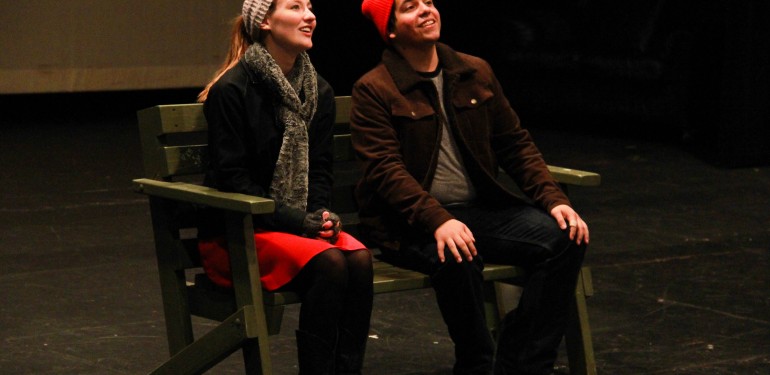Two very different plays with one common thread: love.
From Wednesday through Sunday, the plays “The Blue Room” and “Almost, Maine” will alternate performances in the Mason Fringe.
Ken Elston’s, director of the School of Theatre, wrote that the Mason Fringe is meant to recall the feeling of fringe theater festivals that are becoming a worldwide phenomenon. The challenge is for students to try to approach work creatively, without major production costs or technical support.
Elston does have a point, however. Both shows used their actors, lighting and sound design to their full potential to create entertaining, energetic and thoughtful productions.
“The Blue Room,” written by David Hare and directed by senior film major Alex Galloway, is a series of 10 vignettes with two characters in each. One character from the last scene carries through to the following, so every character is in two scenes. The show finishes by tying together loose ends.
It was a play I read, and admittedly did not like. At first, it seemed like a story with several dislikable characters trying to fulfill desire. While this remains true, “The Blue Room” is really a play that explores the idea of how sex influences relationships.
It brings together people from different walks of life and asks the question: how does sex change or affect this relationship? The play uses sex as a fleeting act that can exist with or without love and with or without commitment. Galloway took this idea and seemingly directed his actors to explore their immediate or gut reactions to the material.
“Almost, Maine” by John Cariani is quite different in its pursuit to understand relationships. As director, senior theatre major Nerissa Hart explains in her note, “[in the play] love is actually a concrete thing that can be externalized as well as felt internally.”
The play occurs in seven vignettes, with a new set of characters in each scene. It is naturally a sweet play that can easily be too cheesy. Hart, however, was able to keep the characters grounded to make a show that was sweet but also funny and relatable.
Both shows had phenomenal ensembles. Even though there were rarely more than two actors on stage at a time, in all cases they had to create chemistry quickly. If the actors had not, the show would have fallen flat.
At times, aspects of the shows were slightly unclear. In “The Blue Room,” it was sometimes hard to decipher a character’s motivation. In “Almost, Maine,” it was difficult for the audience to understand the concreteness of love. But scenes were short and as an audience member, I did not go into the process of figuring out each character’s backstory.
They were both well-done productions. I went into both skeptical. I appreciate how the shows were paired together, bringing different perspectives on love. I came out surprised, and it was nice to be entertained by meaningful stories.
Photo by Erika Eisenacher




